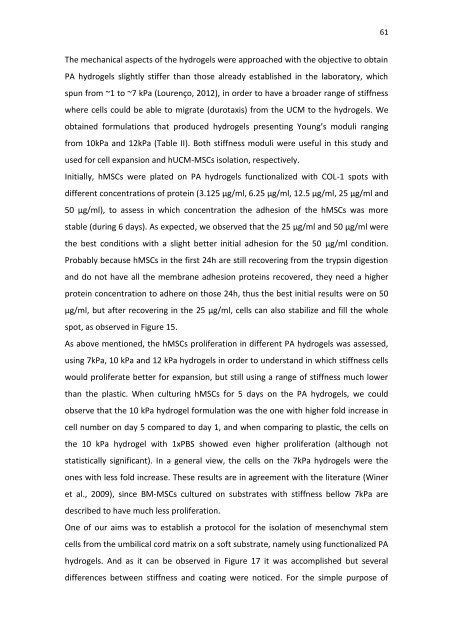DEPARTAMENTO DE CIÊNCIAS DA VIDA ... - Estudo Geral
DEPARTAMENTO DE CIÊNCIAS DA VIDA ... - Estudo Geral
DEPARTAMENTO DE CIÊNCIAS DA VIDA ... - Estudo Geral
Create successful ePaper yourself
Turn your PDF publications into a flip-book with our unique Google optimized e-Paper software.
61<br />
The mechanical aspects of the hydrogels were approached with the objective to obtain<br />
PA hydrogels slightly stiffer than those already established in the laboratory, which<br />
spun from ~1 to ~7 kPa (Lourenço, 2012), in order to have a broader range of stiffness<br />
where cells could be able to migrate (durotaxis) from the UCM to the hydrogels. We<br />
obtained formulations that produced hydrogels presenting Young’s moduli ranging<br />
from 10kPa and 12kPa (Table II). Both stiffness moduli were useful in this study and<br />
used for cell expansion and hUCM-MSCs isolation, respectively.<br />
Initially, hMSCs were plated on PA hydrogels functionalized with COL-1 spots with<br />
different concentrations of protein (3.125 µg/ml, 6.25 µg/ml, 12.5 µg/ml, 25 µg/ml and<br />
50 µg/ml), to assess in which concentration the adhesion of the hMSCs was more<br />
stable (during 6 days). As expected, we observed that the 25 µg/ml and 50 µg/ml were<br />
the best conditions with a slight better initial adhesion for the 50 µg/ml condition.<br />
Probably because hMSCs in the first 24h are still recovering from the trypsin digestion<br />
and do not have all the membrane adhesion proteins recovered, they need a higher<br />
protein concentration to adhere on those 24h, thus the best initial results were on 50<br />
µg/ml, but after recovering in the 25 µg/ml, cells can also stabilize and fill the whole<br />
spot, as observed in Figure 15.<br />
As above mentioned, the hMSCs proliferation in different PA hydrogels was assessed,<br />
using 7kPa, 10 kPa and 12 kPa hydrogels in order to understand in which stiffness cells<br />
would proliferate better for expansion, but still using a range of stiffness much lower<br />
than the plastic. When culturing hMSCs for 5 days on the PA hydrogels, we could<br />
observe that the 10 kPa hydrogel formulation was the one with higher fold increase in<br />
cell number on day 5 compared to day 1, and when comparing to plastic, the cells on<br />
the 10 kPa hydrogel with 1xPBS showed even higher proliferation (although not<br />
statistically significant). In a general view, the cells on the 7kPa hydrogels were the<br />
ones with less fold increase. These results are in agreement with the literature (Winer<br />
et al., 2009), since BM-MSCs cultured on substrates with stiffness bellow 7kPa are<br />
described to have much less proliferation.<br />
One of our aims was to establish a protocol for the isolation of mesenchymal stem<br />
cells from the umbilical cord matrix on a soft substrate, namely using functionalized PA<br />
hydrogels. And as it can be observed in Figure 17 it was accomplished but several<br />
differences between stiffness and coating were noticed. For the simple purpose of
















